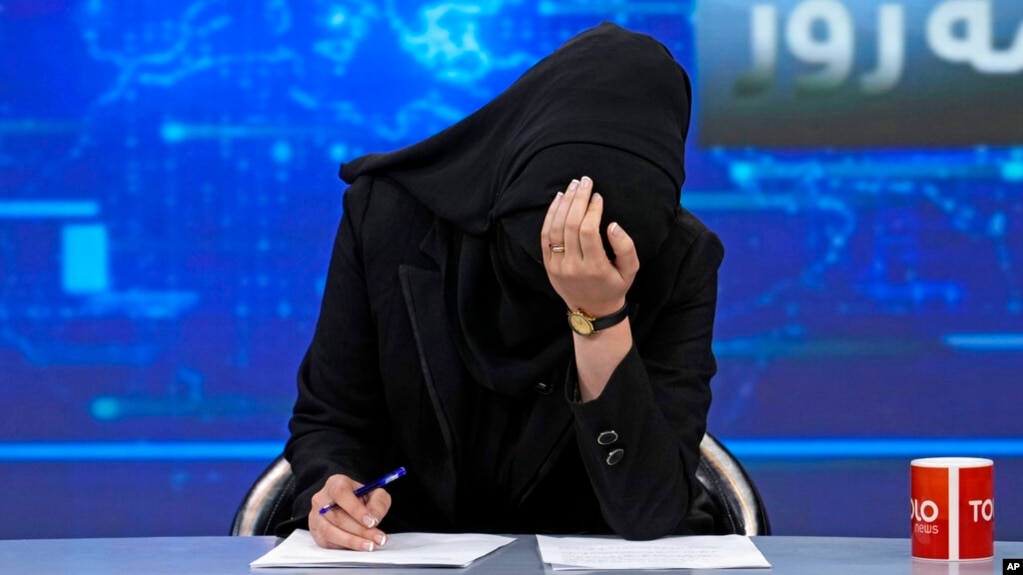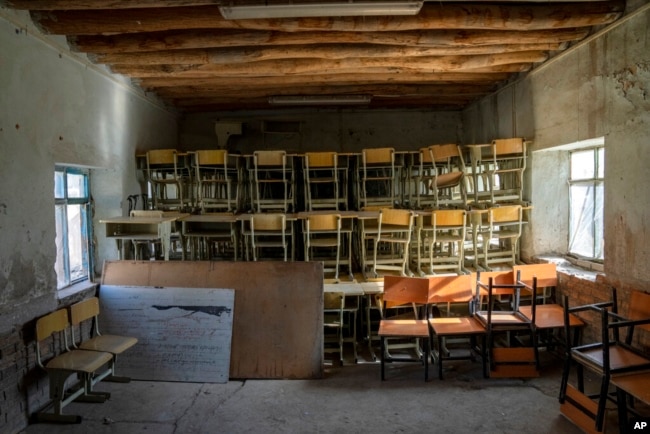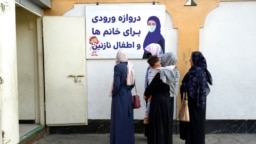August 30, 2023
Akmal Dawi

TV anchor Khatereh Ahmadi bows her head while wearing a face covering as she reads the news on TOLO NEWS, in Kabul, Afghanistan, May 22, 2022, after Taliban rulers required all female TV news anchors in the country to cover their faces while on-air.
In 2016, a young girl, whom we will call Zarghona to protect her identity, embarked on a remarkable journey in central-south Afghanistan. At just 14 years old, she joined a local radio station in Ghazni province, eager to make her voice heard. Initially entrusted with a daily entertainment program for young people, Zarghona's charisma and talent soon led her to more challenging assignments.
"I presented a culinary program, as well as a cultural awareness program," she said, her voice tinged with nostalgia.
By 2021, Zarghona's career was soaring, and she had dreams of pursuing higher education in journalism in Kabul and working for the national media in the capital city.
Before the year's end, though, everything changed dramatically.
As the Taliban swept into power in August of that year, one of their first acts was to indefinitely suspend secondary education for girls, extinguishing the hopes of countless young women like Zarghona. The new Islamist regime also terminated the employment of almost all female public servants, with few exceptions, in the education and health sectors.

In 2016, a young girl, whom we will call Zarghona to protect her identity, embarked on a remarkable journey in central-south Afghanistan. At just 14 years old, she joined a local radio station in Ghazni province, eager to make her voice heard. Initially entrusted with a daily entertainment program for young people, Zarghona's charisma and talent soon led her to more challenging assignments.
"I presented a culinary program, as well as a cultural awareness program," she said, her voice tinged with nostalgia.
By 2021, Zarghona's career was soaring, and she had dreams of pursuing higher education in journalism in Kabul and working for the national media in the capital city.
Before the year's end, though, everything changed dramatically.
As the Taliban swept into power in August of that year, one of their first acts was to indefinitely suspend secondary education for girls, extinguishing the hopes of countless young women like Zarghona. The new Islamist regime also terminated the employment of almost all female public servants, with few exceptions, in the education and health sectors.

A classroom that previously was used for girls sits empty in Kabul, Afghanistan, Dec. 22, 2022.
The national broadcasting agency, Radio and Television Afghanistan, saw all of its female journalists dismissed, and private TV channel anchors were compelled to wear face masks.
Under the Taliban's gender-based discriminatory regime, female journalists are barred from interviewing male government officials, forbidden from participating in press conferences without a male chaperone, and restricted from traveling for reporting purposes.
These rules, unapologetically designed to push women out of journalism, paint a grim picture for Zarghona and many other young women who desperately want to work as journalists.

SEE ALSO:
Women in Afghanistan Facing Numerous Taliban Restrictions in 2022
Despite this bleak reality, for about two years, Zarghona has waited anxiously for an announcement from the Taliban that schools and universities would reopen for girls, and women would be allowed to return to work.
Others hold no such hope.
"I see the future even darker. The restrictions [against women] are increasing day after day, and the Taliban do not care how we suffer," said Madina Bamyani (not her real name), a journalist in the central Bamyan province.
The three journalists who spoke with VOA for this article still reside in Afghanistan, but they all asked to remain anonymous, fearing reprisals from the Taliban.
Targeted persecution
Earlier this year, Bamyani received a job offer from a U.S.-based Afghan media outlet to produce video reports about alleged Taliban atrocities in Bamyan and nearby provinces.
The private media sector — once a thriving industry thanks to the international support it received — has been crushed as Taliban restrictions force hundreds of journalists and media professionals to seek asylum in countries around the world.

SEE ALSO:
Fading Afghan Media Give Space to Disinformation
Outside their homeland, some Afghan journalists have managed to secure funding and launch digital news and analysis outlets aimed at Afghan audiences. But working for those outlets is perilous in Taliban-ruled Afghanistan.
"After I produced a report about the ban on women's beauty salons, the Taliban investigated and discovered my identity," Bamyani said. Fearing detention, she fled to Kabul after her employers warned her they would not be able to help if the Taliban found out about her work for them.

SEE ALSO:
Afghan Women Protest Taliban Ban on Beauty Salons
The United States has played a significant role in supporting Afghan media development over the past two decades, spending more than $220 million on media support programs, according to the Special Inspector General for Afghanistan Reconstruction.
In September 2022, a year after the Taliban seized power, the U.S. Agency for International Development allocated $20 million for projects supporting Afghan media, including $5 million in grants and a nearly $12 million award that aims to deliver news and educational content for Afghans until mid-2026.
"The United States remains committed to supporting the fundamental right of freedom of expression, including for journalists and human rights defenders, and supports their ability to operate freely without fear of violence against them," said a spokesperson for the U.S. State Department.
Taliban officials accuse media organizations from abroad that produce content for Afghans of spreading lies and propaganda, and they have targeted reporters and producers working for such outlets.
Parwiz Shamal, an Afghan journalist and founder of Chalawsaf, an Afghan media observer organization, said the Taliban have detained several reporters on charges that they worked for media entities that are not permitted to operate in Afghanistan.
"Nobody is there to defend those reporters because the Taliban consider these outlets illegal, and like in any other country, work for a disallowed organization bears legal responsibilities," Shamal said.
Information blackout
When the Taliban announced the closure of beauty salons for women in July, there was no public debate or critical media coverage about it.
"We are forced to comply with their misogynistic orders knowing well that those orders are against us," said Yagana Niekhandish, a female journalist in Herat province.
"If I refuse to comply, the Taliban's intelligence agency will throw me in jail overnight," she said.

The national broadcasting agency, Radio and Television Afghanistan, saw all of its female journalists dismissed, and private TV channel anchors were compelled to wear face masks.
Under the Taliban's gender-based discriminatory regime, female journalists are barred from interviewing male government officials, forbidden from participating in press conferences without a male chaperone, and restricted from traveling for reporting purposes.
These rules, unapologetically designed to push women out of journalism, paint a grim picture for Zarghona and many other young women who desperately want to work as journalists.

SEE ALSO:
Women in Afghanistan Facing Numerous Taliban Restrictions in 2022
Despite this bleak reality, for about two years, Zarghona has waited anxiously for an announcement from the Taliban that schools and universities would reopen for girls, and women would be allowed to return to work.
Others hold no such hope.
"I see the future even darker. The restrictions [against women] are increasing day after day, and the Taliban do not care how we suffer," said Madina Bamyani (not her real name), a journalist in the central Bamyan province.
The three journalists who spoke with VOA for this article still reside in Afghanistan, but they all asked to remain anonymous, fearing reprisals from the Taliban.
Targeted persecution
Earlier this year, Bamyani received a job offer from a U.S.-based Afghan media outlet to produce video reports about alleged Taliban atrocities in Bamyan and nearby provinces.
The private media sector — once a thriving industry thanks to the international support it received — has been crushed as Taliban restrictions force hundreds of journalists and media professionals to seek asylum in countries around the world.

SEE ALSO:
Fading Afghan Media Give Space to Disinformation
Outside their homeland, some Afghan journalists have managed to secure funding and launch digital news and analysis outlets aimed at Afghan audiences. But working for those outlets is perilous in Taliban-ruled Afghanistan.
"After I produced a report about the ban on women's beauty salons, the Taliban investigated and discovered my identity," Bamyani said. Fearing detention, she fled to Kabul after her employers warned her they would not be able to help if the Taliban found out about her work for them.

SEE ALSO:
Afghan Women Protest Taliban Ban on Beauty Salons
The United States has played a significant role in supporting Afghan media development over the past two decades, spending more than $220 million on media support programs, according to the Special Inspector General for Afghanistan Reconstruction.
In September 2022, a year after the Taliban seized power, the U.S. Agency for International Development allocated $20 million for projects supporting Afghan media, including $5 million in grants and a nearly $12 million award that aims to deliver news and educational content for Afghans until mid-2026.
"The United States remains committed to supporting the fundamental right of freedom of expression, including for journalists and human rights defenders, and supports their ability to operate freely without fear of violence against them," said a spokesperson for the U.S. State Department.
Taliban officials accuse media organizations from abroad that produce content for Afghans of spreading lies and propaganda, and they have targeted reporters and producers working for such outlets.
Parwiz Shamal, an Afghan journalist and founder of Chalawsaf, an Afghan media observer organization, said the Taliban have detained several reporters on charges that they worked for media entities that are not permitted to operate in Afghanistan.
"Nobody is there to defend those reporters because the Taliban consider these outlets illegal, and like in any other country, work for a disallowed organization bears legal responsibilities," Shamal said.
Information blackout
When the Taliban announced the closure of beauty salons for women in July, there was no public debate or critical media coverage about it.
"We are forced to comply with their misogynistic orders knowing well that those orders are against us," said Yagana Niekhandish, a female journalist in Herat province.
"If I refuse to comply, the Taliban's intelligence agency will throw me in jail overnight," she said.

Afghan beauticians close their beauty salon in Kabul, Afghanistan, July 24, 2023.
The Taliban's intelligence agency has been accused of detaining, and in some cases torturing, about 50 journalists during the past two years, free press groups have reported.
In rural areas, the suppression of women's voices is even more severe, with local Taliban and religious leaders banning women from radio broadcasts, effectively silencing them from public conversations.
Human rights groups say the Taliban's anti-women policies are aimed at erasing women from all public spheres, but Taliban officials maintain they are committed to women's rights — as long as they are within the confines of Islamic Sharia and local traditions.
As Afghan women vanish from public life, access to credible information about their living conditions, from health to income to education, becomes increasingly unavailable.
The Taliban have dissolved the two state institutions — the Ministry of Women's Affairs and the Afghanistan Independent Human Rights Commission — that monitored and reported on women's issues and proposed policies to empower them.
"I guess everybody knows what's happening in Afghanistan, it is an official femicide," Zarghona said.
"What pains me more is that I'm not able to report it to the world."
The Taliban's intelligence agency has been accused of detaining, and in some cases torturing, about 50 journalists during the past two years, free press groups have reported.
In rural areas, the suppression of women's voices is even more severe, with local Taliban and religious leaders banning women from radio broadcasts, effectively silencing them from public conversations.
Human rights groups say the Taliban's anti-women policies are aimed at erasing women from all public spheres, but Taliban officials maintain they are committed to women's rights — as long as they are within the confines of Islamic Sharia and local traditions.
As Afghan women vanish from public life, access to credible information about their living conditions, from health to income to education, becomes increasingly unavailable.
The Taliban have dissolved the two state institutions — the Ministry of Women's Affairs and the Afghanistan Independent Human Rights Commission — that monitored and reported on women's issues and proposed policies to empower them.
"I guess everybody knows what's happening in Afghanistan, it is an official femicide," Zarghona said.
"What pains me more is that I'm not able to report it to the world."
No comments:
Post a Comment